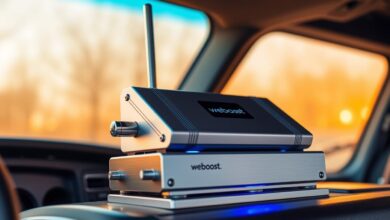Boost Your Home Studio with weboost
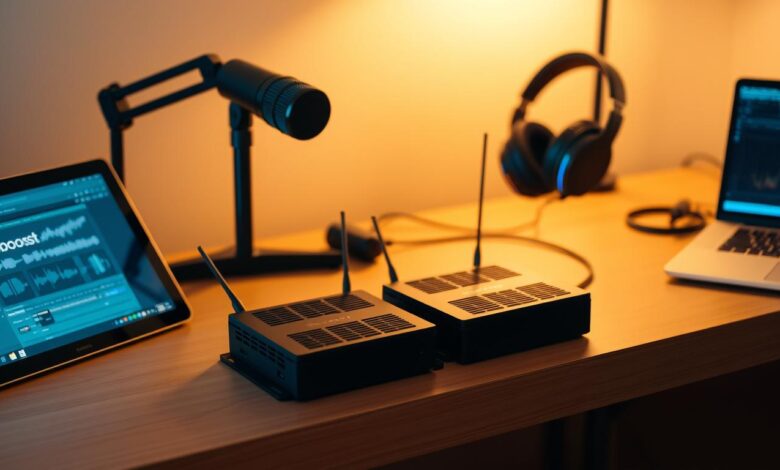
As a home studio owner, I know how annoying dropped calls and bad internet can be. weboost signal boosters can really change the game. They make your studio’s connection better and boost your work.
With a weboost system, you get a stronger, more reliable signal. This means you can talk to clients and colleagues without any hitches. Whether you’re recording, video chatting, or streaming, a signal booster keeps you connected.
Improving your home studio’s connection lets you focus on making great content. In this article, we’ll see how weboost can make your home studio more productive and efficient.
Key Takeaways
- weboost signal boosters can enhance home studio connectivity
- A stronger signal ensures seamless communication and productivity
- weboost systems are designed to improve signal reliability
- Improved connectivity allows for focus on content creation
- weboost can help achieve a more productive home studio
What is a weboost Signal Booster for Home?
weboost signal boosters are designed to boost your cellular coverage. They are crucial for home studios. A strong signal is key for smooth communication and data transfer.
To get why weboost signal boosters matter, let’s look at what they do.
Understanding Signal Boosters
A signal booster amplifies weak cellular signals. This makes your connection stronger and more reliable. Weboost devices capture, boost, and rebroadcast signals to improve coverage.
The main parts of a signal booster system are:
- An external antenna to catch the signal
- A booster to make the signal stronger
- An internal antenna to send out the boosted signal
This setup greatly improves your cellular signal. It gives you a stable connection for calls, data, and more.
How weboost Works
weboost signal boosters enhance your cellular network’s signal strength. With a weboost system, you get better call quality, faster data, and a reliable connection.
The process is simple:
- Catch the cellular signal with an external antenna
- Boost the signal with the weboost device
- Send out the amplified signal to your home studio with an internal antenna
For more details on weboost signal boosters for home offices, check out https://www.weboost.com/boosters/home-office-signal-boosters.
Knowing how weboost signal boosters work helps you choose the right one for your home studio’s cellular needs.
Benefits of Using weboost in Your Home Studio
weboost signal boosters make your home studio better by giving you strong and reliable cell service. This is key for pros who need fast and stable internet for their jobs.
Enhanced Call Quality
Using weboost in your home studio means better call quality. You get clearer and more reliable calls, cutting down on dropped calls and bad audio. This is a big plus for those who make client calls, do interviews, or join online meetings.
Faster Data Speeds
weboost also means faster data speeds for your home studio. This is great for uploading big files, working with your team online, or using cloud services. Faster data speeds help you work better and meet deadlines sooner, without slow internet getting in the way.
Improved Streaming and Gaming
For those who stream or game online, weboost makes things smoother. It cuts down on lag and buffering, so you can enjoy your work or play without interruptions. This makes your home studio time more fun and productive.
| Benefits | Description | Impact on Home Studio |
|---|---|---|
| Enhanced Call Quality | Clearer and more reliable calls | Improved communication with clients and team members |
| Faster Data Speeds | Efficient uploading and downloading | Increased productivity and faster project completion |
| Improved Streaming and Gaming | Smoother streaming and reduced lag | Enhanced entertainment and professional streaming quality |
Types of weboost Signal Boosters Available
The weboost range offers several signal booster types for different needs. You can choose from boosters for a single room, your whole home, or outdoor use. Each is designed to meet your specific requirements.
Home Room Boosters
Home room boosters are perfect for improving signal in one room or area. They’re great for small spaces or to fix signal issues in a specific room.
Multi-Room Boosters
For bigger homes or those needing signal in many rooms, weboost’s multi-room boosters are ideal. They handle complex signal distribution, ensuring strong signals in every room.
Outdoor Boosters
Outdoor boosters are made for use outside, enhancing signal in gardens, patios, or large outdoor areas. They’re perfect for homes with big outdoor spaces where signal strength matters.
| Type | Coverage Area | Ideal Use |
|---|---|---|
| Home Room Boosters | Single room or small area | Small homes or signal dead zones |
| Multi-Room Boosters | Multiple rooms or entire home | Large homes or comprehensive coverage |
| Outdoor Boosters | Outdoor areas | Gardens, patios, or outdoor workspaces |
Knowing the different weboost signal boosters helps you choose the right one. Whether for a single room, your whole home, or outdoor use, there’s a booster for you.
How to Choose the Right weboost Signal Booster
Choosing a weboost signal booster is like picking the perfect tennis racket. You need to think about several things to get the best results.
For better connectivity in your home studio, the right weboost signal booster is key. First, you must assess your home’s layout to find the best booster for you.
Assessing Your Home Layout
Knowing your home’s layout is important for picking the right weboost signal booster. Think about your home’s size, number of rooms, and where you need better signal. A weboost signal booster for big homes might not be right for smaller ones.
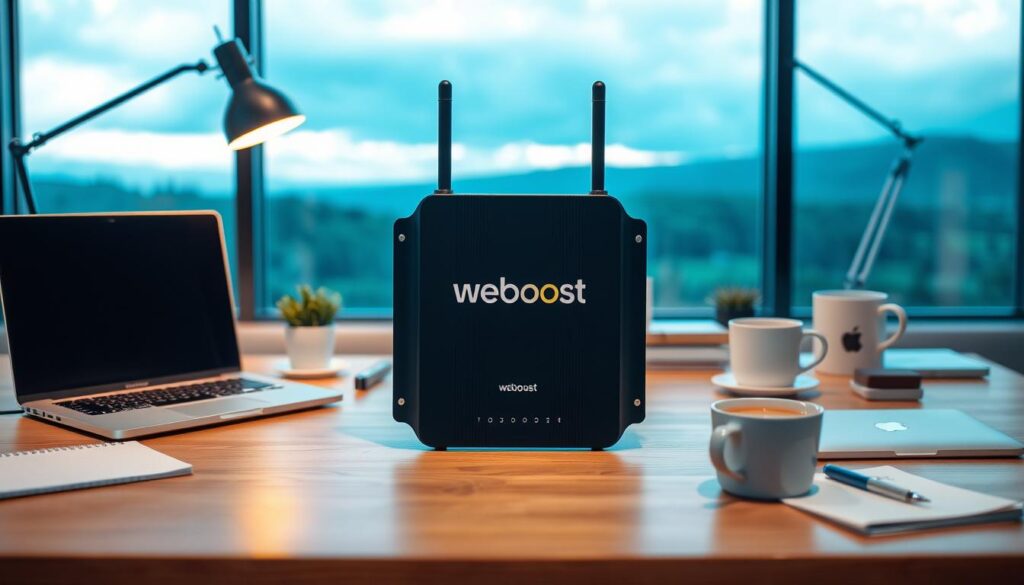
Considering Your Cellular Network
Your cellular network is another big factor. Weboost signal boosters work with different networks, so pick one that matches yours. Find out what network you use and choose a booster that supports it.
By thinking about these points, you can pick a weboost signal booster that fits your needs. It will improve your home studio’s connectivity.
Installation Guide for Your weboost Device
Starting a weboost installation means knowing the tools and steps needed. It boosts your home studio’s connectivity. This makes communication and data transfer smooth.
Tools You’ll Need
Before starting, gather all necessary tools and parts. You’ll need the weboost signal booster, an outside antenna, an inside antenna, coaxial cables, and a power supply. Having everything ready makes the installation easier.
- The weboost signal booster unit
- An outside antenna to capture the signal
- An inside antenna to distribute the signal within your home studio
- Coaxial cables to connect the antennas to the booster
- A power supply for the booster
Step-by-Step Installation Process
The installation has several key steps. First, find the best spot for your outside antenna to get the strongest signal. You might need to try a few places and use a signal strength meter.
Next, install the outside antenna in the chosen spot. Make sure it’s securely attached and points towards the nearest cell tower.
Then, configure your inside antenna in your home studio. It’s important to place it where it will cover the most area.
After setting up the antennas, connect them to the weboost signal booster with coaxial cables. Make sure all connections are tight to prevent signal loss.
Finally, power on the weboost device and check the signal strength in your home studio. This ensures the boost is working as expected.
By following these steps and making sure each part is correctly installed, you’ll see better connectivity and performance in your home studio.
Troubleshooting Common Issues with weboost
Using a weboost signal booster can sometimes lead to common problems. But, with the right troubleshooting, these issues can be fixed easily. Knowing how to solve these problems can make your experience with the device much better.
Connection Problems
Many users face connection issues with their weboost signal boosters. These can include dropped calls, slow data speeds, or trouble connecting to the network. To fix these problems, check how your weboost is set up.
Make sure the outdoor antenna is aimed at the nearest cell tower. Also, ensure there are no things blocking the antenna’s view of the tower.
It’s also important to check the cables. Bad or damaged cables can hurt your weboost’s performance. Look for any damage on the cables and replace them if needed. Also, make sure all connections are tight and not loose.
If you’re still having trouble, look at the user manual or reach out to weboost’s customer support. You can also find more help in our guide on why your cell phone booster isn’t working.
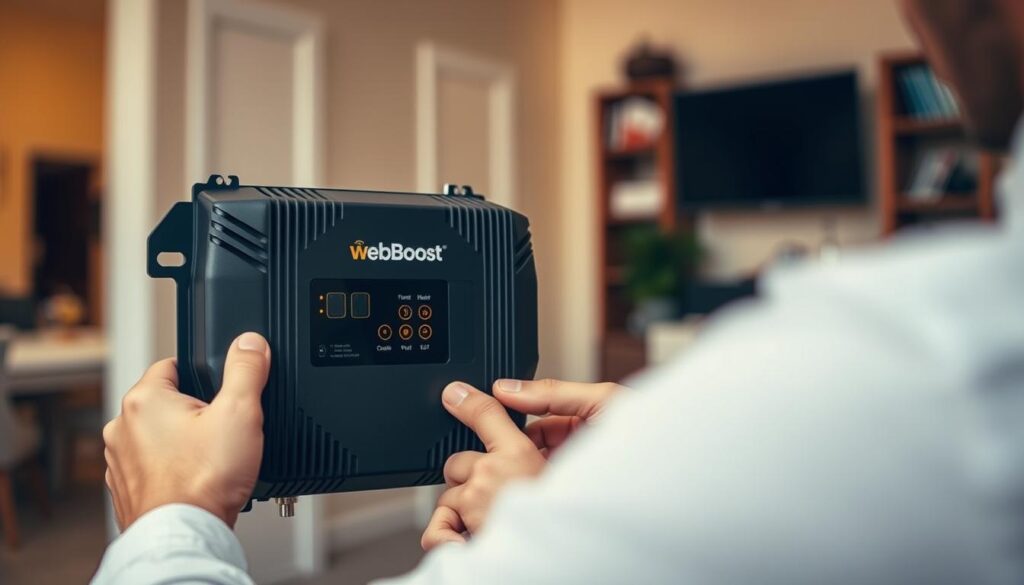
Interference Resolution
Interference is another common problem with weboost signal boosters. It can be caused by other devices, physical barriers, or building materials. To solve these issues, find out what’s causing the interference and fix it.
Try moving your weboost device and its parts to different spots. This might help reduce interference from other devices. Also, using a weboost with better interference filtering can improve your signal.
Experts say that proper setup and configuration are key to avoiding interference. Make sure your weboost is installed and set up right for the best results.
By tackling common problems like connection issues and interference, you can make your weboost work better. This will give you a more reliable and fast cellular signal.
Maximizing the Performance of Your weboost System
To get the most out of your weboost system, it’s crucial to understand how to maximize its performance. Think of it like fine-tuning a tennis racket for a perfect serve; every adjustment matters.
Maximizing your weboost system’s performance involves two key aspects: optimal placement and regular maintenance. By focusing on these areas, you can significantly enhance your home studio experience.
Optimal Placement Tips
The placement of your weboost device plays a critical role in its effectiveness. Here are some tips to ensure you get the best out of your device:
- Place the outdoor antenna in a location with the strongest signal reception.
- Ensure the indoor antenna is positioned to provide coverage throughout your home studio.
- Avoid placing the device near other electronic devices that could cause interference.
Proper placement is key to maximizing weboost performance. By strategically positioning your device, you can enjoy stronger signals and faster data speeds.
Regular Maintenance Practices
Regular maintenance is essential to ensure your weboost system continues to perform optimally. Here are some practices to follow:
- Regularly check for software updates to ensure your device is running with the latest improvements.
- Inspect the antennas and cables for any signs of damage or wear.
- Reboot your device periodically to maintain its efficiency.
By incorporating these maintenance practices into your routine, you can extend the lifespan of your weboost system and maintain its performance.
In conclusion, maximizing the performance of your weboost system requires attention to both optimal placement and regular maintenance. By following these guidelines, you can enjoy a more reliable and efficient connectivity experience in your home studio.
Real User Reviews and Testimonials
Real user experiences show the benefits of weboost signal boosters in home studios and other places. By looking at what real users say, we learn how well the product works and what it could do better.
Positive Experiences
Many users have seen a big improvement in their cell signal after using weboost. For example, one user said they had fewer dropped calls and faster data speeds.
Some common good points from weboost users are:
- Enhanced Call Quality: Users like weboost for making calls clearer and fewer dropped calls.
- Faster Data Speeds: Many have noticed their data speeds go up, making streaming and browsing easier.
- Reliable Connectivity: weboost is praised for giving a steady signal, even in bad coverage areas.
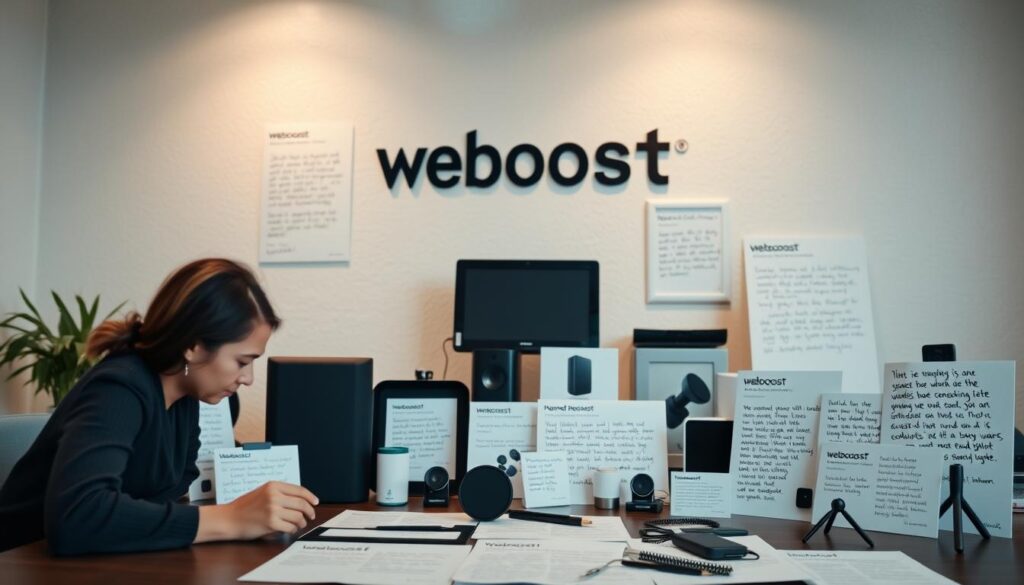
Challenges Faced
Even though most feedback is good, some users have faced problems with weboost. Common issues include:
- Installation Difficulties: A few users found setting it up harder than they thought.
- Interference Issues: Some have had trouble with other devices causing problems for weboost.
But, these problems aren’t for everyone and can depend on where you are. weboost’s customer support is known for helping fix these issues.
In summary, what users say about weboost shows it can really help with cell signal in home studios and more.
Comparing weboost with Other Signal Boosters
When you want to improve your home studio’s internet, knowing how weboost stacks up is key. The market has many signal boosters, each with its own strengths. It’s important to compare weboost with others to choose wisely.
Comparing signal boosters is like comparing tennis rackets. You look at coverage, signal boost, and network compatibility. weboost signal boosters are known for their reliability. But how do they compare to others?
Key Differences with Competitors
weboost and other boosters differ in how they boost signals. weboost aims for a strong, reliable connection, reducing dropped calls and lost data. For example, when comparing weboost to Wilson Electronics or weboost and Wilson Pro models, as shown on Signal Booster’s comparison page, weboost shines in ease of use and performance.
- Coverage Area: weboost has products for various home sizes.
- Signal Amplification: weboost’s amplification power is strong, often better than others.
- Compatibility: weboost works with all major US cellular networks.
Value for Money Analysis
Value for money isn’t just the initial cost. It’s about total cost, including installation, upkeep, and service quality. weboost boosters might cost more at first but offer long-term value due to their durability and performance.
In summary, comparing weboost to other boosters involves looking at tech, coverage, and cost. By understanding these differences and evaluating value, you can choose the best for your home studio.
Staying Compliant with FCC Regulations
Following FCC guidelines is crucial for weboost signal boosters. It’s not just about following the law. It also ensures your booster works its best.
Understanding Legal Limitations
Using a weboost signal booster means knowing the FCC rules. These rules stop interference with cell networks. They also make sure boosters don’t harm others.
FCC rules set limits on how much a booster can amplify signals. It’s important to stick to these limits.
The FCC also says boosters must not disturb other users. This means you need to reduce the chance of interference. Do this by installing and setting up your weboost correctly.
Ensuring Proper Use
To use your weboost right, follow the maker’s instructions. This includes correct installation and upkeep. Also, check how well it’s working and tweak settings if needed.
Also, know if you need to register your booster with the FCC. This helps the FCC keep an eye on boosters. It lowers the chance of interference and makes sure you’re following the rules.
By sticking to FCC rules, weboost users can enjoy better cell service. They do this without hurting anyone else’s experience.
Conclusion: Transform Your Home Studio Experience with weboost
Adding a weboost signal booster to your home studio can really make a difference. It boosts call quality, speeds up data, and makes streaming better. Weboost solves many connectivity problems.
Recap of Key Benefits
Using weboost in your home studio brings many benefits. You get better call quality, faster data, and smoother streaming and gaming. Choosing the right weboost model means you’ll have reliable and efficient internet.
Final Thoughts on Investing in Connectivity
Getting a weboost signal booster is a smart move for your home studio. It offers a range of models and is easy to set up. Weboost is a great choice for anyone looking to improve their studio’s internet.
FAQ
What is a weboost signal booster and how does it work?
A weboost signal booster is a device that makes weak cellular signals stronger. It captures the signal, boosts it, and then sends it out again. This helps areas with poor coverage, like home studios, get better signal.
What are the benefits of using weboost in my home studio?
Using weboost in your home studio can make calls clearer, data faster, and streaming and gaming better. It helps you work more efficiently and stay connected.
What types of weboost signal boosters are available for home use?
weboost has different boosters for home use. There are boosters for one room, multiple rooms, and outdoor use. Each is made for different needs and coverage areas.
How do I choose the right weboost signal booster for my home studio?
To pick the right weboost, look at your home’s layout and your network. This helps you find the best booster for your space and network.
How do I install my weboost device?
To install your weboost, you’ll need some tools and a step-by-step guide. You’ll set up the outdoor and indoor antennas to boost your signal.
What are some common issues with weboost signal boosters and how can I resolve them?
Issues with weboost boosters include connection problems and interference. Try moving your antennas, check your installation, or contact weboost support for help.
How can I maximize the performance of my weboost system?
For the best performance, place your devices right and keep them maintained. Check for updates and make sure your antennas are secure.
Is weboost compliant with FCC regulations?
Yes, weboost boosters follow FCC rules. It’s important to know the legal limits and use your device correctly to avoid problems.
How does weboost compare to other signal booster brands?
weboost is known for reliability and performance. When comparing, look at coverage, signal strength, and value to find the best for you.
What kind of support does weboost offer for their signal boosters?
weboost offers support through their website, customer service, and technical help. They can help with any issues or concerns you have.
